
9 June 2018
I never forgot Cheung Chau. Back in 1978 it was one of the most exotic places I’d ever seen. Hong Kong itself was exotic enough with markets in the narrow alleys, and people living on junks, but Hong Kong also had much that was familiar – crowds and tall buildings, traffic and public transport. Cheung Chau had none of that, and I’d never seen anything quite like it. Somehow this little island captured my imagination and wouldn’t let go. Cheung Chau, meaning Long Island, is one of the 260+ outlying islands of Hong Kong. There is still a ferry from Central on Hong Kong Island that takes you there and you still arrive at a peaceful fishing village. I remember the narrow streets, the ramshackle buildings and stores, and most of all how quiet it was. There were no cars on Cheung Chau, no vehicles at all. It dwelt in my imagination as this kind of tumbledown unpolished gem where people lived simple lives close to the water. It wasn’t shiny, but it had realness, and character. So on this recent visit to Hong Kong I was determined to get back there.
A few days ago I pulled out the scrapbook I’d made of my travels back then and looked at my few faded grainy photos. I was surprised to discover it hasn’t changed that much, at least not the view of the street that runs alongside the harbour.
And neither has the main street.
I was also surprised to discover that today the population of Cheung Chau is about 22,000. It was probably half that, or less in 1978. There are still no cars, only diminutive service vehicles, and the fishing fleet is still active.
I don’t have long to explore Cheung Chau, and I don’t go far. The island is wide at both ends with a narrow waist, and the ferry deposits you at the town on the west side of the narrowest part of the island. It doesn’t take long for me to walk straight across and discover the beach on the other side. It’s not that I was looking for the beach. I didn’t even remember that it was there, but if you walk from the ferry into the town you soon come to a wide-open square, and on the far side of it is an ancient sacred tree that the local people regard as lucky.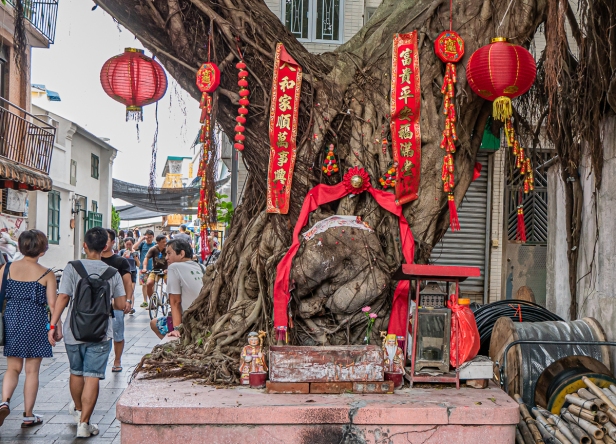
From there if you just follow your nose it’s pretty inevitable that you’ll end up at the beach. The centre part of this dumbbell-shaped island is so narrow that you can walk from one side to the other in less than ten minutes.
I wander along the beach for a while, enjoying the mild weather, but it’s really the town I’m interested in, the town and the people. So I walk the streets back towards the seafront looking for ordinary daily life.
I explore some of the back alleys and narrower streets. Buildings seem to pile on top of one another but few are higher than three stories and there’s a feeling of cohesiveness, as if the buildings have collected themselves together into one entity.
From a little way up a hill I look down into cluttered courtyards decorated with plastic chairs, fishing gear, brooms and mops and umbrellas, and clotheslines hung with laundry. I walk down narrow alleys,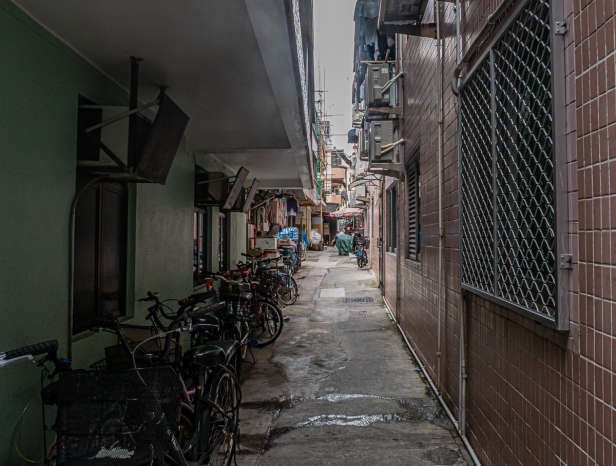
every one of them adorned with bicycles, and some lush with planters and small gardens.
A woman pushes a cart of cardboard to be recycled,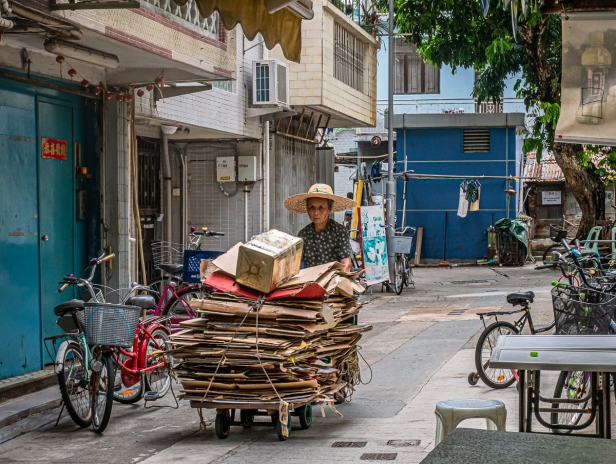
small shops and restaurants line the narrow streets,
and although just a short walk away from the residential area it is quite busy, the entire place feels homey and easy-going. Families are out shopping.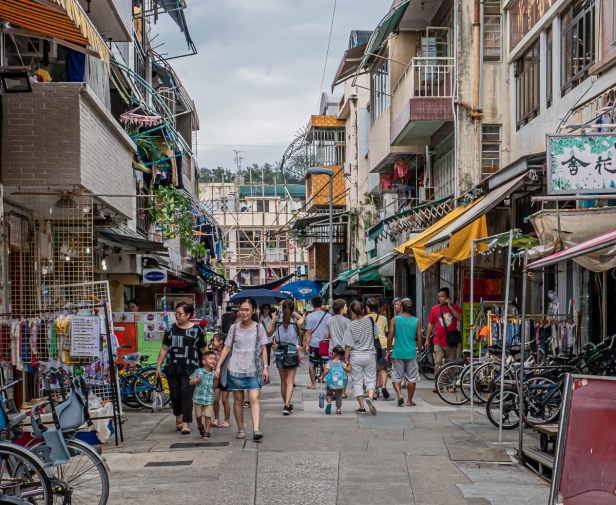
Everyone is walking or on bikes. No one rushes. Life seems gentle, relaxed, unhurried.
I get back to the harbour and walk by the infinite assortment of seafood restaurants lined along Pak She Praya Rd running parallel to the waterfront. There is a whole world of life to see on the water.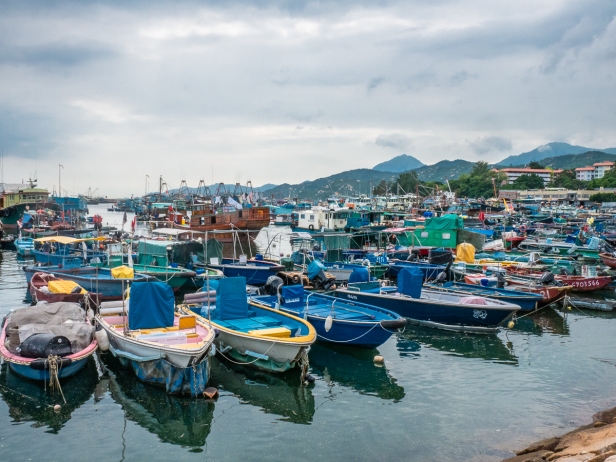
People live there, in all manner of boats, jam-packed together, elbowing for space. If the streets feel relatively free and easy, the harbour is packed. The boats come in all shapes and sizes, and in all stages of dilapidation, cobbled together with tarps and tubing, some string and a prayer.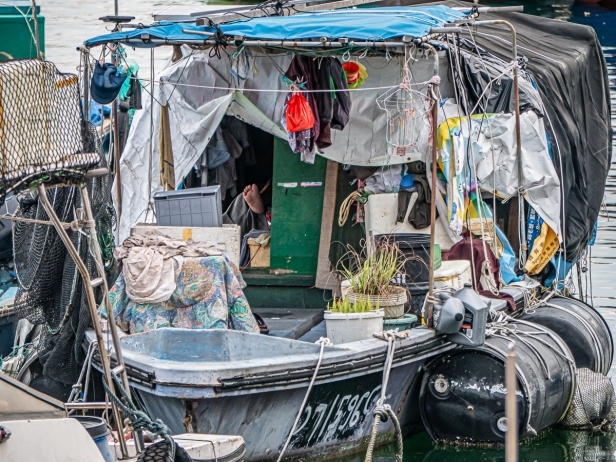
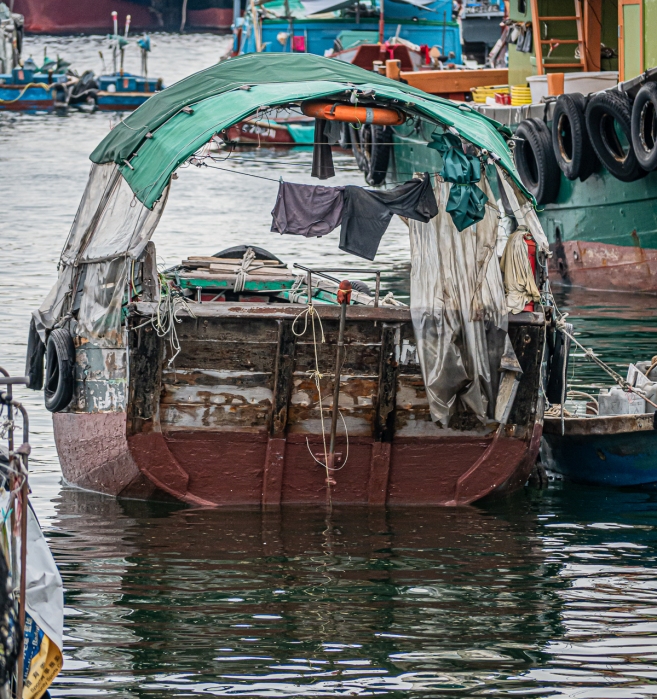
There are several elderly junks offering a comparatively spacious home,
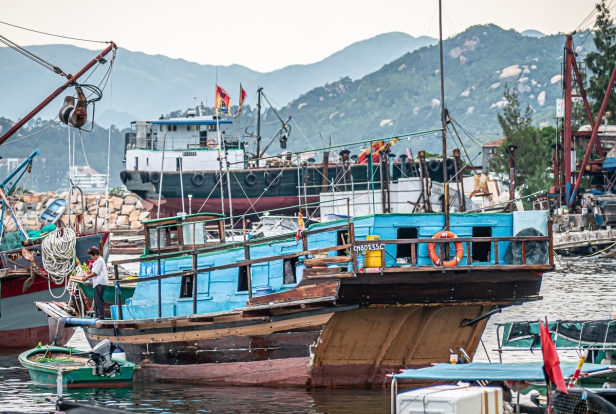
and fishing trawlers,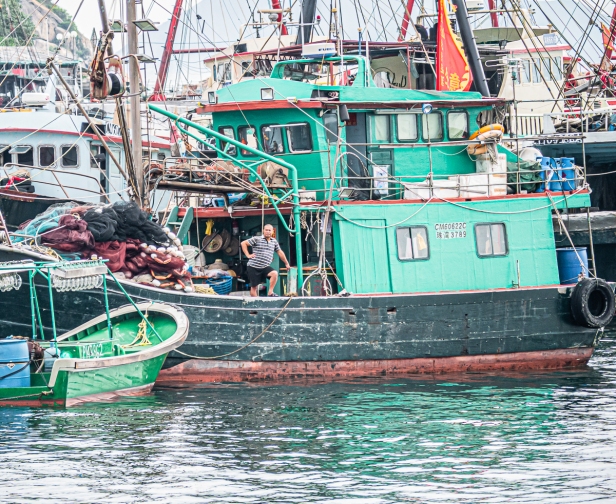
and in between all the boats, in spaces you’d hardly believe even existed, are men going about their business on the water.
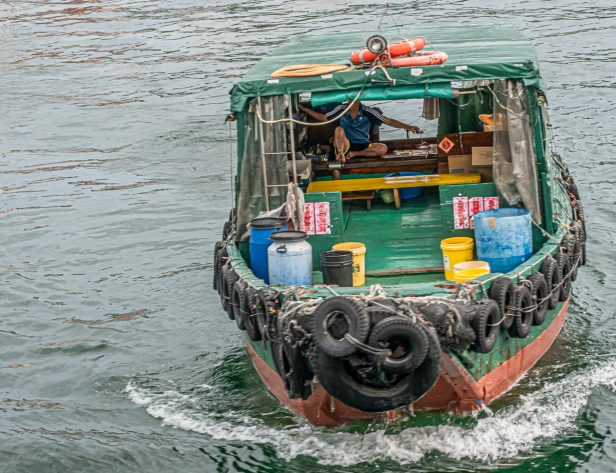


Cheung Chau has become a popular weekend destination for Hong Kongers wanting to escape the crowds and the heat of summer in the city, and I can see why. And I imagine at the height of the season the streets, and the beach, and the hiking trails and restaurants are a lot more crowded.
Forty years ago Cheung Chau was a charming sleepy fishing village with nothing much else going on. Fortunately it has retained much of its character despite the passage of time and the influx of tourists. I could still feel its beating heart.
Back in 1978 my travel companion and I took a ferry from the docks at Central to a small fishing village on Lantau Island. From there we hiked a trail through lush forest that led us up over the central hills to the Po Lin Monastery. In those days I was not so interested in monasteries, but I remember it being a fairly unassuming place shrouded in mist and mystery. We continued on the trail to another small fishing village on the other side of the island and caught a ferry back to Central. The whole feeling of the island was that it was a largely unknown backwater – quiet, peaceful, mostly uninhabited, shrouded in fog, lost in time. I don’t remember how we found out about the hike back in those pre-internet days. Probably from a book called something like Asia on a Shoestring.
They built a huge much-needed new airport on Lantau. And a freeway connecting it to Hong Kong Island and from there to the mainland. And a Disneyland resort. And a whole new town. From pictures I see that Po Lin Monastery is now a quite grand affair, and close by there is also a colossal bronze Buddha. I knew it was no longer the island I’d been to forty years back so considering my short stay in Hong Kong on this visit I decided not to return.
I do return to Lamma Island. I have no memories of Lamma. The only reason I know I went there is that I have a single foggy faded photograph that, although labelled Lamma Island, is actually a view from the hills of Lamma.
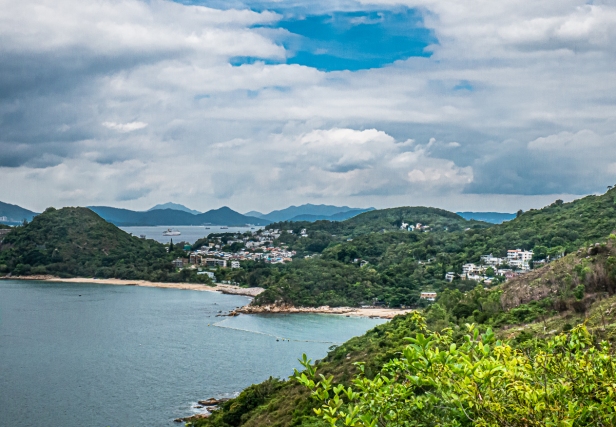
There’s a fishing village on the eastern side of the island called Sok Kwu Wan (Rainbow Bay) that you can reach by ferry from Central. The village of Sok Kwu Wan on land is not much more than a low-key row of seafood restaurants and small stores,


but the harbour has a life of its own.
On the water there is another kind of village: fish-farming frames and small ramshackle floating homes fill the bay.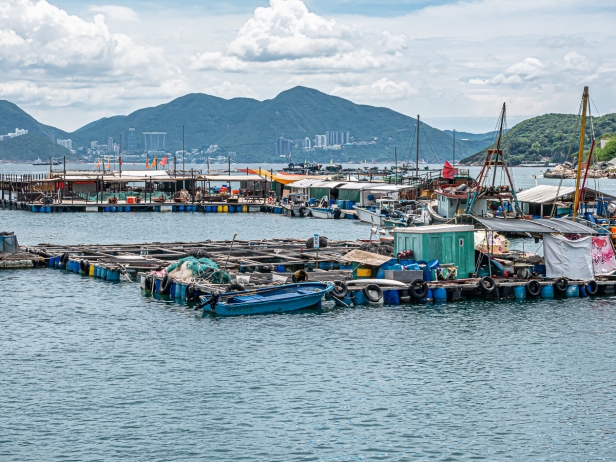

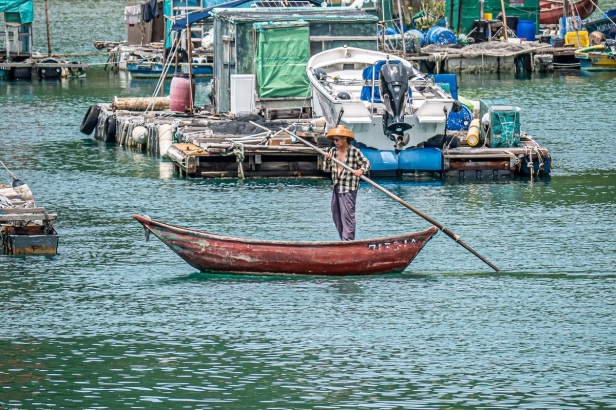
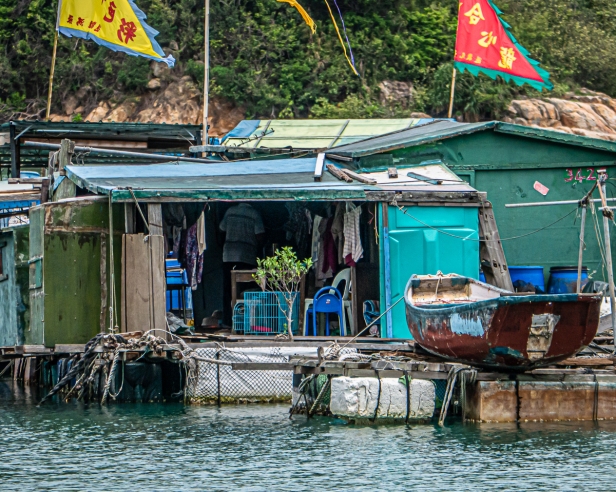
All told there are about 300 people living in this sleepy community.
It is one of the few places that has retained the customs and traditions of the old fishing families. Close to the crowded high-rises and streets of one of the busiest and most densely populated cities in the world, just a thirty-minute ferry-ride away, is this entirely different realm immersed, despite some modern trappings, in a kind of slow easy timelessness.
There is a four-kilometre paved pathway from Sok Kwu Wan on the eastern side of the island to Yung Shue Wan (Banyan Tree Bay) on the north end of the island. Well if you count ferry dock to ferry dock it’s closer to five kilometres. It takes you past a small Tin Hau temple dedicated to the Sea Goddess Lin Mo; follows around the curve of Sok Kwu Bay past beaches where people walk their dogs on this fresh June day; past a huge cave where the Japanese concealed speedboats to use on suicide missions; through leafy gardens and a small village;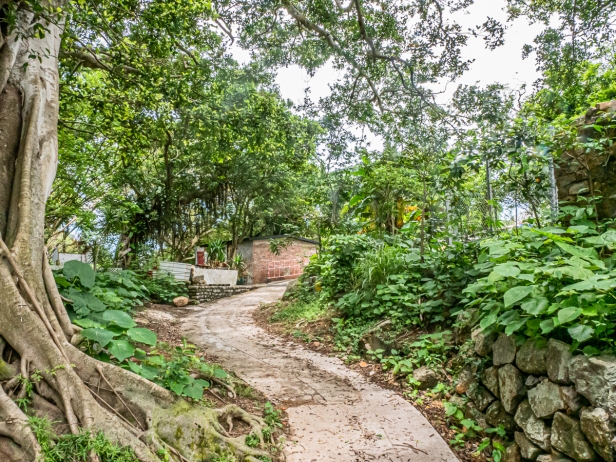
past some sitting areas and pavilions for enjoying the view; along the ridges of the dry hills with views back to the fish farms of Sok Kwu Wan, and across to other islands;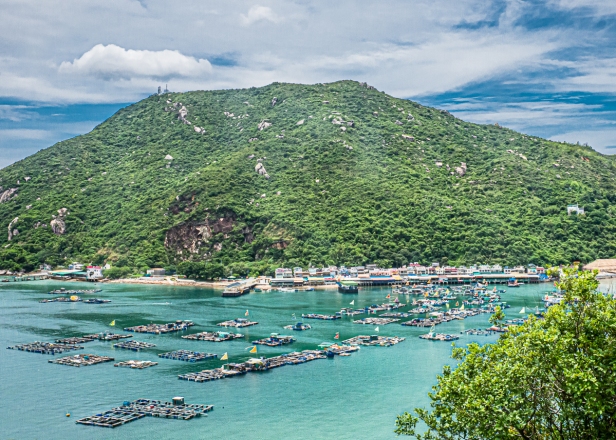

and through pandanus and bamboo groves;
until finally you come to Hung Shing Ye Beach
and so on into the village of Yung Shue Wan which is this
and this
and this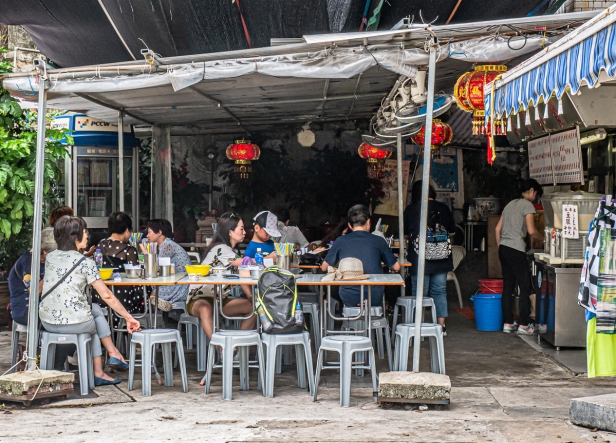
and much more.
Lamma is the third largest of all Hong Kong’s islands, and most of its estimated 6000 people live in Yung Shue Wan. It’s a vibrant town with stores and restaurants and a significant ex-pat community that gives the place an east-west feel. Like Cheung Chau there are no vehicles except those needed for services and emergencies. People walk or use bicycles, and there’s a three-story limit on the height of buildings. No high-rises allowed here! Lamma in known for its alternative lifestyle and easy-going attitude.
I poke around some of the narrow alleys
and pass the Tin Hau Temple
on my way to the main street that runs parallel to the bay. Here there is the life of the town: pubs, grocery stores, shops, handicrafts, cafes, an international mix of restaurants,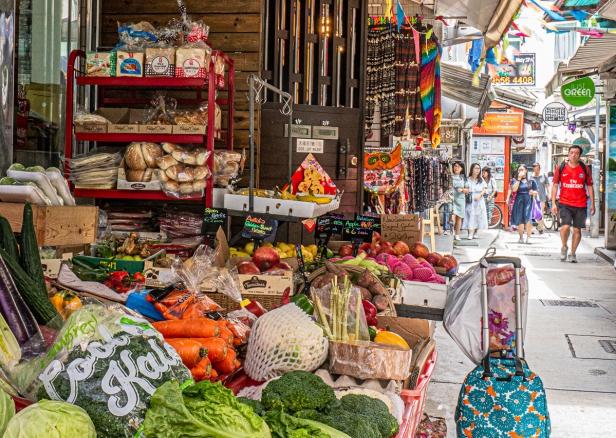

and right on the sidewalk a place to buy really really fresh fish.
As I leave on the ferry I look back at Yung Shue Wan and wish I’d had more time there.
My visits to both Lamma and Cheung Chau were a bit rushed with both packed into one day. I only had three days in Hong Kong and on the first one the rain came bucketing down and pretty much put an end to going anywhere. On the third day I went hiking.
Next post: hiking the Dragon’s Back.
All words and images by Alison Louise Armstrong unless otherwise noted
© Alison Louise Armstrong and Adventures in Wonderland – a pilgrimage of the heart, 2010-2019.

Thanks for this tour. I love seeing how people live on and around the water.
LikeLiked by 1 person
Oh you’re welcome! It was fun to put it together. They’re such real communities.
Alison
LikeLiked by 1 person
Fascinating!
LikeLiked by 1 person
It really was! I’m so glad I did this little excursion. It really hasn’t changed that much from when I was there all those years ago.
Alison
LikeLiked by 1 person
I’ve only ever transitted through HK airport! So interesting to read about areas unlike the high rise we see on the news – especially current news! The lives there must be so far removed from what we’re seeing…
LikeLiked by 1 person
Incredible photography, well done!
LikeLiked by 1 person
Thank you so much Chris.
Alison
LikeLike
I visited Hong Kong twice, but never strayed far from town, and in both cases I was either reeling from bad news at home or feeling sick. I ought to come back, and I ought to check out Cheung Chau.
LikeLiked by 1 person
That’s too bad about your experiences of Hong Kong! Hope you get back there one day, and get a chance to explore the little islands.
Alison
LikeLiked by 1 person
Wow, what a lovely place to explore and photograph, you certainly captured it beautifully! I love seeing people get on with their day on the other side of the world! Thanks for sharing and have a good day 😀 Aiva
LikeLiked by 1 person
Thank you so much. And you’re welcome! I’m glad you enjoyed it. I too love seeing the daily life of the people in the places I travel too. In the end we are all so much the same even if our circumstances are different.
Alison
LikeLike
One of the joys of travel is going back and seeing places again. This is probably one of the few places in China that hasn’t changed much in 40 years.
Your quote – “Everyone is walking or on bikes. No one rushes. Life seems gentle, relaxed, unhurried.” That doesn’t sound like the Hong Kong Iknow! I can see why you liked it and the locals enjoy going for weekend trips.
LikeLiked by 1 person
As I said, I never forgot Cheung Chau – it was so very different from the rest of Hong Kong, even then, that I knew I just had to get back to it. And what a lovely surprise to discover that it, and Lamma, haven’t changed that much. Still the same laid-back vibe. And I would imagine you’re right that it’s probably one of the few places in China that hasn’t changed that much in 40 years. What a sweet blessing.
Alison
LikeLike
Fabulous post, Alison. One of the things I miss most about Hong Kong is the fact that no matter where you are in the city, you’re never far from hiking trails, beaches, and incredibly scenic islands. I’ve met quite a few expats who have chosen to live in Lantau, Cheung Chau, or Lamma and commute each day by ferry. The only issue is if they spend a night out in town – what inevitably happens is a mad dash to catch the last boat back shortly before midnight (lest they be stranded).
It boggles the mind that little Cheung Chau is home to 22,000 residents while Lamma has just 6,000 or so – even if it’s much bigger! I don’t know if you got to see it back in 1978, but the southwestern shores of Cheung Chau has what is said to be a pirate cave. I remember clambering down a ladder into a relatively small space there when I was a kid. And a funny anecdote from Lamma – I took Bama there a couple years ago and he asked me if I could recognize a spiny fruit tree growing by the side of the pathway. Being someone who had always grown up in a big city, I didn’t. He found it hilarious that I couldn’t identify a papaya tree though it grows all over Hong Kong. After that I started noticing it everywhere, even on the rooftops of apartment buildings.
Did you have a chance to sit down for a seafood lunch at Sok Kwu Wan? Everything was so fresh when Bama and I went, and a fraction of what you’d expect to pay at restaurants downtown. The strange thing about Lamma is that you have this landmark and eyesore that dominates the western side of the island – a big coal-fired power plant with its three enormous smokestacks built on reclaimed land – that makes for a jarring backdrop to the waters off Hung Shing Ye Beach.
As for Yung Shue Wan, there really is something special about the village. A number of decades ago, around the time you visited, a young Singaporean journalist and his wife were living there. He had previously been imprisoned and held in solitary confinement for two months just for writing articles critical of the Singaporean government (at the time led by the authoritarian figure Lee Kuan Yew). After his release, he got married and the newlyweds moved to Yung Shue Wan, where they enjoyed a simple but idyllic existence living out of a small village flat. Eventually they returned to Singapore to take over the family business, and by the mid-90s they’d started their own five-star hotel chain, which they named Banyan Tree as a tribute to the romance and the magic they’d experienced as a young married couple on Lamma Island. The Banyan Tree brand isn’t really known in Australia or Canada or Europe, but you can find their (very romantic) resorts in Phuket, Bali, Yangshuo, the Maldives, central Vietnam, and so on. I found this out just a few months ago and was utterly amazed by that unexpected connection with Yung Shue Wan.
LikeLiked by 2 people
Thanks so much James. I can totally see why people would choose to live on one of the smaller islands – so quiet and peaceful compared to being in the city, but I can imaging that having to make that mad dash for the last ferry could be challenging at times.
I too was surprised to discover the difference in population between Cheung Chau and Lamma. I wonder why so many flock to Cheung Chau rather than to Lamma? Perhaps it is the ugly power plant on Lamma which I decided simply didn’t exist! I looked the other way and erased it from my mind. And from this post. Chuckle.
I vaguely heard something about the pirate cave but didn’t see it.
I too would not recognize a papaya tree – no wait, I would. They grow all over Mexico. They’re not spiny are they? Scurries off to double-check. No, not spiny, at least I wouldn’t describe them that way. I do hope I’m correct in naming the pandanus in the above photo, and notice there’s bamboo in that grove of greenery too.
I confess I didn’t have a seafood meal there – more fool me! The perfect opportunity for a really good meal, but you know me James – not a foodie. And I was pushed for time to make all the ferries. I have absolutely no memory of what I ate that day, or where.
What a wonderful story about the Singaporean journalist. I certainly remember Lee Kuan Yew.
Now I’m going to check out the Banyan Tree hotels!
Alison
LikeLiked by 1 person
Ah yes, with the papaya trees, I wrote that in a hurry and got my words mixed up. I should really have used “scaly”, not “spiny”, on account of the rough patterns on their tree trunks. Guess I’m still not very good at identifying flora as you can see!
I have mixed feelings about the power plant. It is so ugly but at the same time it is something of a landmark – I’ve never seen Lamma Island without those smokestacks – and at the same time the place is the source of electricity for all of Hong Kong Island.
As for the seafood, I had a quick look at an old post (and one of Bama’s) to see if there was anything adventurous. Apparently we chose a set menu that included calamari and sweet and sour dipping sauce, prawns with crispy bits of deep-fried garlic, and steamed scallop topped with rice vermicelli, garlic, and spring onion. We also had a thick soup cooked with sea snails in their shells. For one person it would have been far too much, and I can understand how you simply didn’t have the time to stop for an hour-long lunch.
LikeLiked by 1 person
OMG that meal sounds amazing. I would have loved it, but yes, time was a factor squishing both islands into one day. I was going to go to Lamma on my first day in HKG with a couple of the people I travelled with in China, but that was the day it rained – really rained! I actually went to Lamma first, walked across the island, then the ferry back to Central then over to the next pier for the ferry to Cheung Chau. I probably ate dreadful takeout from somewhere. 😦
LikeLiked by 1 person
Both of these places are worth noting for future trips to Hong Kong, as it is always a treat to visit places “off the beaten track” that give us a glimpse into daily life that is so different from our own. Fishing villages are one of our favourite places to go to, especially when they are still authentic and working places, rather than touristic sites.
When we were last in Hong Kong we had one day to “play” with and narrowed it down to Hiking the Dragons Back or one of the smaller islands, and in the end opted for the hike and the greenery, as we were in extreme need of being in nature and getting some exercise before a long flight.
Life on the water is always fascinating to see and makes us think about how much space most of us have in our conventional homes compared with the bare minimum when your boat is your home!
Peta
LikeLiked by 1 person
It was such a sweet day to get out of the city and see these two smaller islands – and especially sweet to discover they hadn’t changed much. I would definitely recommend both islands should you find yourselves back in HK. Like you I love to see fishing villages, and life on the water. It’s so exotic to me – a whole different way of life. And I’ve absolutely loved it every time I’ve spent any time on a boat.
I get why you opted for Dragon’s Back on a day before a long flight. It’s a fabulous hike, and at one time was voted the best urban hike in the world by Time magazine, but that was a while ago now. Still, I loved it – great views and a serious workout.
Alison
LikeLike
I’m so eager to see Hong Kong in February! Unfortunately, my time will be even shorter than your recent stop, so I won’t get to any islands. It’s so fun to revisit places you’ve been decades earlier; I’ve done that a few times, and the feelings, memories, spatial orientation, fragrances – everything – can come roaring right back. From what I’ve heard from friends who have lived in Hong Kong, it is as James said above – a great place to have an urban existence and yet have easy access to hiking and islands and all sorts of nature. My kind of place! Looking forward to the hiking post as that is something we want to do in our time there.
LikeLiked by 2 people
It was so fun to get back to Cheung Chau, and even more so to find it was still itself! I know what you mean about revisiting places – so much comes back, and I also find I see places with new eyes. Seeing the Eiffel Tower when I was 50something was a whole different experience from seeing it when I was 20something.
I was lucky to spend 6 weeks in HK the first time I visited. Most people I think don’t give it the time it deserves – to see the city, and get out of the city to some of the other islands, and up into the New Territories (if it’s even still called that). But if you only have one day then Dragon’s Back is a great thing to do. Where else are you going?
Alison
LikeLiked by 1 person
We are doing what I will have to call the SE Asian Sampler! Ha – not usually my style, but my husband’s work schedule does not allow for very long trips, so we will have about 2.5 weeks to visit Laos, Cambodia, and Vietnam (hoping to see Peta and Ben!). The HK stop is just a lucky long layover, so we’ll have a full day in the city. The Dragon’s Back hike is in my sights!
LikeLiked by 1 person
Well you can see/experience a lot in 2.5 weeks – eg my 3.5 weeks in China. I think the Dragon’s back is a great choice for your day in HKG. If you’re going to be in Hanoi do try to see a water puppet show – really authentic to the area and just delightful. Have a great time!
In Feb we’re off back to Rishikesh, and then Malaysia for 2-3 weeks. Yay – a new country!
A.
LikeLiked by 1 person
Fantastic trip for you! Aren’t we so lucky to see so much of this world?!
LikeLiked by 1 person
Lucky indeed!
LikeLiked by 1 person
Sometimes it can be disappointing to return to places filled with great memories visited long ago. Rightly or wrongly, I usually resist the temptation. It’s nice to read that you had good experiences. The islands look lovely and it’s amazing that such a simple/traditional way of life exists so close to downtown Hong Kong.
LikeLiked by 1 person
I had a great experience, and I’m so glad I went back, but yes, I understand it can be a bit of a risk. The three places I’ve been back to and never been disappointed are India, Australia, and Japan. Oh also Mexico. And South America. So I guess my returning record is pretty good. Been lucky I guess.
It really is amazing to find these laid-back traditional places so close to the city. I think I really expected Cheung Chau to have changed enormously given how much more developed the city is, and how much more developed Lantau Island is, so it was such a sweet surprise to find it hasn’t really changed at all except to be a bit busier. But then all those years ago I went in February, not in June at the beginning of summer.
Alison
LikeLike
Photo graphs tells Nature feelings
LikeLiked by 1 person
Thank you so much Mani.
Alison
LikeLike
Alison your description of this Hong Kong with it’s unhurried getaways certainly is a stark contrast to the media reports of Hong Kong today. Do you suppose these areas have been affected by the protests?
LikeLiked by 1 person
I’m not really sure but I suspect that these islands were not so much affected. AFAIK all the protests took place in Kowloon and/or HK Island, though as James says, quite a few people commute to the city from these smaller communities so were probably affected in the way.
I love that life on these islands exists the way it is so close to the big city. I hope it can stay that way.
Alison
LikeLiked by 1 person
This was such a relaxing read on a Saturday morning! I love that you revisited a place that captivated you so many years ago. It’s easy to avoid going back to places in an effort to always see a new part of the world, but sometimes letting your heart lead you back somewhere can be wonderful — especially when the character of the place remains and still enchants you. Amazing that this is the case with Cheung Chau, considering it’s so close to such a huge metropolis as Hong Kong. Thanks for the glimpse at the island life — next time I’m there, I’ll catch a boat. 🙂 Hope you and Don are well! Happy holidays, Alison!
LikeLiked by 1 person
Thanks so much Kelly. I pretty much always want to go somewhere new, but was landing in HKG anyway after the China trip so it was a chance to go back – and Cheung Chau was definitely going back to a place that had captured my heart. It is different – busier, but still the same. I’d have been so disappointed if the island had been covered in high-rises and fancy resorts. I read that more than 3 stories is banned on Lamma, but I’m pretty sure it must be on Cheung Chau too. Such a good rule! A boat to an island, or two, from Hong Kong Central is always a good idea. 🙂
We’re both well, thriving even. We’re off to Montreal for family Christmas, then in the new year back to Rishikesh, India (one of our fave teachers will be there for a month) and then Malaysia! Yay a new country! And tips? I know you lived in that part of the world for a while.
Hope you guys are well too. I see ski season has started 🙂
Happy holidays to you too.
Alison xo
LikeLiked by 1 person
Yes, ski season has started. I’m in a bit of denial that winter is here again but J is diving in as usual! As for Malaysia, we never made it to KL but of course the Petronas Towers are supposed to be a highlight if tall buildings are of interest. I’ve heard great things about the Islamic Arts Museum. The Batu Caves could be interesting, and KL does have some street and food markets. More than anything, I’ve heard that you need to be careful and aware of your surroundings in KL. Outside of there, Melaka is a fun and foodie kind of small historic town (post on my blog), and Langkawi is a pretty beach getaway. Georgetown is also supposed to be a fun town to explore (we didn’t get there). And lastly, I always wanted to see the Cameron Highlands (could be especially good if you’re there in Feb/Mar/Apr after the rainy season). Look into the mystery of silk pioneer Jim Thompson, and if possible visit at least one of his namesake stores. The products are quite beautiful and support the silk trade in Thailand, primarily. There’s an outlet in Bangkok that is pretty much my favorite shop in the whole world! Happy holidays and have fun in Montreal!! ♥
LikeLiked by 1 person
Thanks for this list! The one that jumps out the most is the Cameron Highlands so I’ll check it out. We visited Jim Thompson’s house/museum in Bangkok – quite amazing what he did.
A.
LikeLiked by 1 person
Going to the small islands has now become a must-do activity every time I come to Hong Kong because really that’s one of the great things about the territory — you have a bustling metropolis on one side and quiet villages amid lush forests on the other. It was only last year I finally got the chance to visit Cheung Chau, and I loved it! From the fried ice cream we had, to the whimsical rock formations, peaceful neighborhoods, and this beautiful small shop we went to.
As for Lamma Island, like what James said, our lunch was the highlight. The seafood was fresh and everything cost much cheaper than what you would pay for the same dishes on Hong Kong Island.
LikeLiked by 1 person
So that’s twice I’ve heard about fried ice cream *after* I was there! You can also get it in the Muslim snack street in Xi’an and I missed it there too. We’re going to be in Malaysia in March so I’m for sure going to be on the lookout for it.
I also loved Cheung Chau as I guess you can tell. And Lamma – both so very different from the big city, and not at all the way people generally think of HKG. I’m so glad I got back to both islands. But I have to come back again now – for fried ice cream on Cheung Chau, and a seafood lunch on Lamma!
Alison
LikeLiked by 1 person
I love this image in my minds eye 🤓 ‘Everyone is walking or on bikes. No one rushes. Life seems gentle, relaxed, unhurried…Your photography feels so fitting with your narrative Alison…didn’t know you went 1978….great reflections…thanks for sharing now I want to go ☺️🤓
LikeLiked by 1 person
Thanks so much Hedy. Both islands have that relaxed unhurried feel – so different from the big city just a short ferry-ride away. HKG is definitely worth a visit. I had 6 weeks there back when I was 20something and have never forgotten it. It’s a huge city but it’s also fairly easy to get out of town and into nature if not into the kind of wilderness we have here in Canada.
Alison
LikeLike
Really enlightening. When I think of Hong Kong I think of cityscapes only. Those streets remind me of Tokyo suburbs. Fascinating to see ordinary life anywhere.
LikeLiked by 1 person
Thanks Tracey. I loved these island communities, especially since they are such a huge contrast to how we usually think of HKG.
Alison
LikeLike
Amazing photos. I almost have the feeling walking though the bazaar and the shops and looking at the ships.
LikeLiked by 1 person
Thanks rabirius. I really appreciate your comment as I do try to capture a feel for what it’s like to be there. I like photographing all the big iconic places of course, but I think I most love trying to capture the people and ordinary life.
Alison
LikeLike
What a treat to see your photos and learn about this place, Alison. You have a wonderful way of capturing the sense of a place. I love so many of these but remembering the little foot on the boat, the woman with the cardboard, so many colorful junk boat shots. Thanks for sharing!
LikeLiked by 1 person
Thank you so much Jane. That’s exactly what I try to do – capture the sense of a place, what it’s like to be there, and something about what it’s like to live there. I love the shot of the foot in the boat too, and the woman with the cardboard. Ordinary life.
Alison
LikeLiked by 1 person
Such color! And so many gorgeous boats (although I am not sure I would like to set up housekeeping on some of the smaller, more dilapidated junks)! How cool that there is few vehicles at Cheung Chau (don’t seem to be many on Lamma either) and the fishing fleet rules on both these islands. I love sailing into places like this and so miss sailing in Asia. Adore the sacred tree adorned lovingly in red and all the street action.
LikeLiked by 1 person
Thanks Lisa. Oh they are both such colourful, and interesting, places. And I get why you’d love sailing into places like this, and why you’d miss Asia. There’s such a ramshackle homey realness to it – it’s not polished, but seems nevertheless to work. I could have explored for hours more than I had. Lamma also has no vehicles except very small emergence/service vehicles. I love that about both islands.
Alison
LikeLiked by 1 person
Returning to a place you visited that long ago has to be interesting, to say the least. Your photos, as always, are fascinating – I so appreciate the back-alley view you seek out wherever you go. You packed a lot into one day!! (And how refreshing that vehicles are kept to an absolute minimum.)
LikeLiked by 1 person
Thanks so much Lynn. I love the back alleys; it’s where you get glimpses of realness. And yes, the lack of vehicles on both islands is wonderful. Almost for that alone I think they retain their character.
Alison
LikeLiked by 1 person
What beautiful photos Alison. So much charm and character.
LikeLiked by 1 person
Thanks Nicole. I loved visiting these islands. And thank you for all your comments – I see you’re catching up! Thank you!
Alison
LikeLike
Thank you so much, Alison. I must have overseen your post… until now!!! Wonderful… Bringing back a lot of memories! 🙂 And so nice to read that there are still no vehicles allowed beside the ones for services & emergency. Wonderful pictures… as always!!!
LikeLiked by 1 person
Thanks so much. I so enjoyed visiting these islands. It’s such a totally different side of Hong Kong. HK is one of my fave cities too.
Alison
LikeLiked by 1 person
Thanks Alison for taking me back to Hong Kong! It’s funny, I grew up with stories about this hike on Lantau Island that my parents did in 1978 as well! So in HKSAR, I was hesitating between Lamma Island and Lantau. I opted for the latter. The Buddha is a bit much but the fishing village of Tai O on the opposite side of the island (probably the 2nd one you visited) has retained its character. It was pretty special to spend a night there. Next time, we’ll visit Lamma then!
LikeLiked by 1 person
You’re welcome. I’m glad you enjoyed this little journey back to HK, and find it so interesting that you heard stories of the Lantau Island hike before all the development. I’m happy with choosing these two islands, though I must admit Tai O was a bit of a draw. So next time I’ll probably go to Lantau! And also explore some of the other trails. I find HK such a fascinating place.
Alison
LikeLiked by 1 person